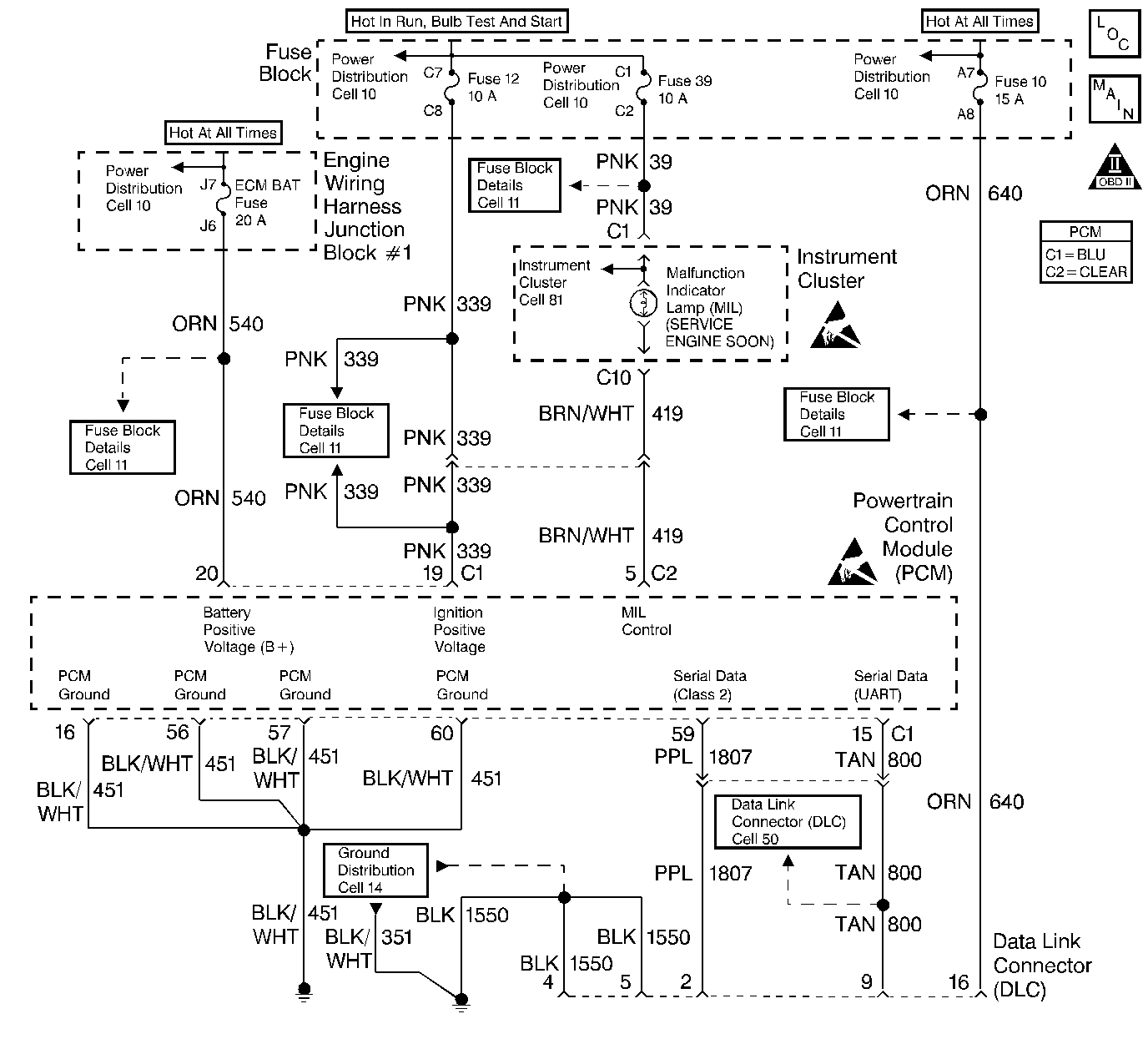
Circuit Description
Ignition voltage is supplied directly to the Malfunction Indicator Lamp. The PCM controls the lamp by grounding the control circuit via an internal switch called a driver. The primary function of the driver is to supply the ground for the component being controlled. Each driver has a fault line which is monitored by the PCM. When the PCM is commanding a component ON, the voltage of the control circuit should be low (near 0 volts). When the PCM is commanding the control circuit to a component OFF, the voltage potential of the circuit should be high (near battery voltage). If the fault detection circuit senses a voltage other than what is expected, the fault line status will change causing the DTC to set.
Conditions for Running the DTC
The ignition is on.
Conditions for Setting the DTC
| • | An improper voltage level has been detected on the MIL control circuit. |
| • | The above condition present for at least 30 seconds. |
Action Taken When the DTC Sets
| • | The PCM will illuminate the malfunction indicator lamp (MIL) during the first trip in which the diagnostic test has been run and failed. |
| • | The PCM will store conditions which were present when the DTC set as Freeze Frame and Failure Records data. |
Conditions for Clearing the MIL/DTC
| • | The PCM will turn OFF the MIL during the third consecutive trip in which the diagnostic has been run and passed. |
| • | The History DTC will clear after 40 consecutive warm-up cycles have occurred without a malfunction. |
| • | The DTC can be cleared by using the scan tool. |
Diagnostic Aids
| • | If the ignition feed circuit is suspected of being open, check if other bulbs on that circuit illuminate. |
| • | Using Freeze Frame and/or Failure Records data may aid in locating an intermittent condition. If the DTC cannot be duplicated, the information included in the Freeze Frame and/or Failure Records data can be useful in determining how many miles since the DTC set. The Fail Counter and Pass Counter can also be used to determine how many ignition cycles the diagnostic reported a pass and/or a fail. Operate vehicle within the same freeze frame conditions (RPM, load, vehicle speed, temperature etc.) that were noted. This will isolate when the DTC failed. |
Test Description
Numbers below refer to the step numbers on the Diagnostic Table:
-
Normally, ignition feed voltage should be present on the control circuit with the PCM disconnected and the ignition turned on.
-
Checks for a shorted component or a short to battery positive voltage on the control circuit. Either condition would result in a measured current of over 500 milliamps. Also checks for a component that is causing an open circuit while being operated, resulting in a measured current of 0 milliamps.
-
Checks for a short to voltage on the control circuit.
-
This vehicle is equipped with a PCM which utilizes an Electrically Erasable Programmable Read Only Memory (EEPROM). When the PCM is being replaced, the new PCM must be programmed. Refer to Powertrain Control Module Replacement/Programming .
Step | Action | Values | Yes | No |
|---|---|---|---|---|
1 | Was the Powertrain On Board Diagnostic (OBD) System Check performed? | -- | ||
Is the voltage near the specified value? | B+ | |||
Does the current reading remain between the specified values? | 0.05-0.5 amps (50-500 mA) | |||
Is the voltage at the specified value? | 0.0V | |||
5 | Locate and repair short to voltage in the MIL control circuit. Refer to Wiring Repairs in Wiring Systems. Did you complete the repair? | -- | -- | |
6 | Check the ignition feed fuse for the instrument panel indicators. Is the fuse blown? | -- | ||
7 |
Did you complete the repair? | -- | -- | |
8 |
Is the voltage near the specified value? | B+ | ||
9 |
Was a problem found? | -- | ||
10 |
Was a problem found? | -- | Go to Instrument Cluster System Check in Instrument Panel, Gauges, and Console. | |
11 |
Does the test light flash on and off? | -- | Go to Diagnostic Aids | |
12 |
Was a problem found? | -- | ||
13 | Locate and repair the open in the ignition feed circuit to the I/P indicators. Refer to Wiring Repairs in Wiring Systems. Did you complete the repair? | -- | -- | |
|
Important: : The replacement PCM must be programmed. Replace the PCM. Refer to Powertrain Control Module Replacement/Programming . Did you complete the repair? | -- | -- | ||
15 |
Does the scan tool indicate DTC P1641 failed this ignition? | -- | System OK |
